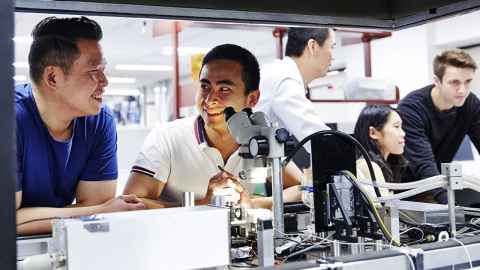Work-loop calorimeter
Developed by ABI, this device is the world’s only flow-through calorimeter for measuring the properties of realistically contracting individual heart muscles.
The calorimeter simultaneously measures the mechanical (force, length) and energetic (heat production, mechanical work) properties of contracting heart muscles.
It combines sensitive temperature sensors with a sophisticated laser-interferometer based force-length control system. An oxygen- and nutrient-rich solution flows over the muscle, so the muscle can be precisely exposed to a wide variety of drugs.
The muscle is electrically stimulated, causing it to contract and create a force-length ‘work-loop’ realistically modelled on the pressure-volume behaviour of the whole heart. With this device, we can programmatically vary the work done by a living heart muscle while measuring its energy consumption.
We measure the rate at which heat is produced by the muscle to 100 nW resolution while controlling muscle length to 2 nm resolution and force to 1 μN resolution. Experiments are conducted at a controlled temperature of up to 40 °C.
Research
Our ‘experimental cardiac energetics’ team have made some recent discoveries using this calorimeter:
- Pulmonary arterial hypertension reduces the efficiency of muscles from the right ventricle but does not affect those of the left ventricle.
- Heart muscle samples from the right ventricle shorten faster yet are just as efficient as those from the left ventricle.
- ‘Shortening heat’ does indeed appear to arise in cardiac muscle.
- ‘Activation heat’ is independent of muscle length and can be estimated by the y-intercept of the heat-stress relation.
- Salt-induced hypertension changes the shortening behaviour of the left ventricle but has no effect on peak work output or peak mechanical efficiency.
- Despite others’ claims to the contrary, we find no evidence of dietary fish oil improving cardiac efficiency.
The device is being used in several major ongoing studies
- Amy Garrett is developing methods for measuring energetic efficiency during time-varying afterloads.
- Dr June-Chiew Han is using it to compare the energetic performance of the muscle with that of the whole heart.
- Associate Professor Kenneth Tran is collecting data on the effect of Type 2 diabetes on cardiac efficiency for a Marsden and NHF study.

Publications
- Loiselle, D. S., Taberner, A. J., Tran, K., & Han, J.-C. (2021). Thermodynamic inconsistency disproves the Suga-Sagawa theory of cardiac energetics [Journal paper]. Progress in Biophysics and Molecular Biology.
- Han, J.-C., Loiselle, D., Taberner, A., & Tran, K. (2021). Re-visiting the Frank-Starling nexus [Journal paper]. Progress in Biophysics and Molecular Biology, 159, 10-21.
- Tran, K., Taberner, A. J., Loiselle, D. S., & Han, J.-C. (2020). Energetics Equivalent of the Cardiac Force-Length End-Systolic Zone: Implications for Contractility and Economy of Contraction. Frontiers in Physiology, 10, 1633.
- Pham, T., Nisbet, L., Taberner, A., Loiselle, D., & Han, J. C. (2018). Pulmonary arterial hypertension reduces energy efficiency of right, but not left, rat ventricular trabeculae [Journal paper]. The Journal of Physiology, 596(7), 1153-1166.
- Taberner, A. J., Zgierski-Johnston, C. M., Pham, T., Han, J., Uddin, R., Loiselle, D. S., Ruddy, B. P., & Nielsen, P. M. F. (2018). A Flowthrough Infusion Calorimeter for Measuring Muscle Energetics: Design and Performance [Journal paper]. IEEE Transactions on Instrumentation and measurement, 67(7), 1690-1699.
- Garrett, A. S., Pham, T., Loiselle, D., Han, J.-C., & Taberner, A. (2019). Mechanical loading of isolated cardiac muscle with a real-time computed Windkessel model of the vasculature impedance. Physiological Reports, 7(17), e14184-e14184.
Researchers and graduate students
Engineering Team
- Professor Andrew Taberner
- Professor Poul Nielsen
Experimental team
- Dr June-Chiew Han
- Associate Professor Kenneth Tran
- Associate Professor Denis Loiselle
- Toan Pham
- Amy Garrett
Collaborators
- University of Melbourne (the hypertrophic heart rat study)
- University of Kentucky (the failing human heart tissue study)
- University of Michigan (the high-salt diet study)
- University of Stuttgart (the cardiac-titin study)
- Associate Professor Nari Kim (Inje, Korea) has developed multi-scale mathematical models of heart tissue using data measured from this instrument.
Funding partners
- Administered by the Royal Society of New Zealand, Marsden Fund
- Health Research Council of New Zealand
- New Zealand’s Heart Foundation
- US National Institutes of Health
- Vice-Chancellors Strategic Development Fund, University of Auckland
- Faculty Research Development Fund, University of Auckland
- Maurice and Phyllis Paykel Trust
- World Congress of Biomechanics
- Auckland Medical Research Fund
- Lotteries Health